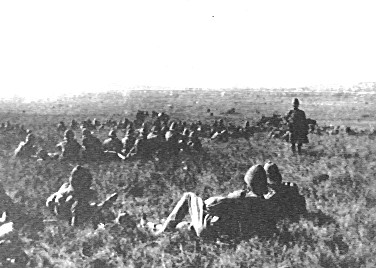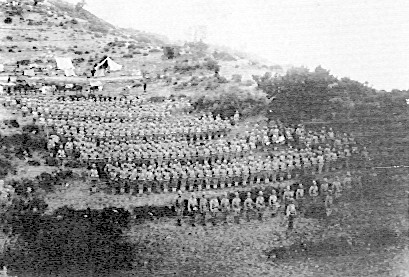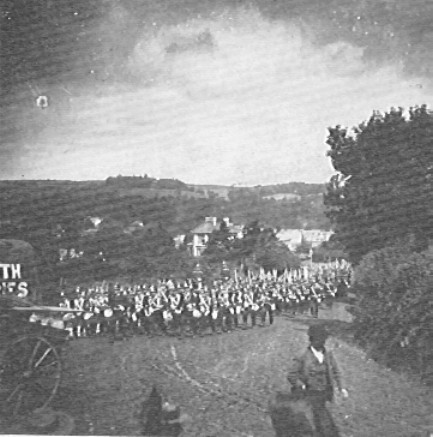[ Extract taken from 'The Bedfordshire & Hertfordshire Regiment' by G.W.H. Peters pp. 44-55 - ISBN 0 85052 034 7]
Chapter
4
The South African War
THE BRITISH national conscience has never been easy about the Boer War. The propaganda of those jealous of the British Empire; the early humiliations we suffered, and the passage of time have confused our minds as to the real issue. For this war was fundamentally about gold. We had a case and the country mobilized in support of it with the greatest enthusiasm.
Until gold was discovered in the Transvaal the Boers lived in pastoral tranquility in an inhospitable country. They had trekked there from the Cape in 1836 to escape British rule. But when Kruger and his Government saw the vast wealth being created in their midst they wanted a share of it. So they taxed the miners, or Uitlanders as they called them, who had brought brains, skill and capital to dig it out, that were almost entirely British. Unfortunately they could not bring themselves to give the Uitlanders political representation. The Uitlanders rebelled. They had sufficient political and financial influence at home to involve the British Government; also a slogan 'no taxation without representation' which appealed, as always to the British people. Moreover it was the Boers who declared war and invaded British territory in Natal and Cape Province.
 Beneath the hot South African sun the Bedfords take a rest on the veldt. |
It was the utterly unexpected and bewildering disasters of the first three months which shook the nation's confidence. John Bull was groggy at the knees. Ladysmith, Kimberley and Mafeking were invested. The greatest Empire the world has ever known had been defeated ignominiously at Colenso, Stormberg and Magersfontein. The Boers were better led, more mobile and their fieldcraft and marksmanship were highly skilful. Our Army lumbered unimaginatively about in the open, often without direction, uncertain as to the whereabouts of the enemy and were shot down in staggering numbers before they could come to grips with him. Each fresh humiliation we suffered added another skip to the Kaiser's dance of delight. Other nations, equally jealous, accused us of outmoded and highhanded imperialism. Morale both at home and in the field slumped to zero. The grievances of the Uitlanders were forgotten and a feeling of guilt set in. Perhaps after all we were acting the big bully that others made us out to be. |
The arrival of Lord Roberts at Cape Town in December 1899 put an end to indecision. Like Montgomery before Alamein, he at once introduced purpose and organization. Like Montgomery also, he visited commanders and units personally and lifted morale from the boot-lace level to which it had fallen.
The 2nd Bedfords arrived at Cape Town with 12 Brigade of 6 Division on January 8, 1900. The first thing they did in accordance with Lord Roberts' call for more mounted men was to form two mounted infantry companies.
Lord Roberts' simple plan was to relieve Kimberley and march on north to capture the Transvaal capital Pretoria, a total distance of some 1,000 miles. The Bedfords were part of the cover plan force, which drew off a superior number of the enemy to the area of Colesberg. The first stage of the plan was successful. For the first time a Boer General, Cronje, was outwitted and captured. Kimberley was relieved and Bloemfontein, the capital of the Orange Free State, fell on March 13. The Bedford Mounted Infantry were with the cordon that surrounded Cronje, and played a gallant part in the operation, all the officers being hit. The stage was now set for the advance on Johannesburg and Pretoria. The 6th Division remained in the Free State to contain the considerable Boer forces available to cut Lord Roberts' communications with Pretoria. The risks of this pencil-like thrust into enemy territory were considerable. With Kimberley, Ladysmith and Mafeking relieved the initiative had passed to the British side. Nevertheless the enemy were still strong and had given a very good account of themselves in recent rather inconclusive fighting round Bloemfontein, resulting from a pause to re-equip and re-supply. Every mile advanced now would make the supply route more tenuous; every detachment dropped to protect it would weaken the main body. Against this, every step forward into what was now Boer territory increased the enemy's panic and brought nearer an alternative supply centre at Johannesburg. Time and morale were nicely balanced. Had the Boers made a really determined effort to cut the supply line, or hold up the advance by concentrating on some of the excellent tactical obstacles available the story might have been different. But Lord Roberts was too quick, and too enterprising. It was Kruger who lost his nerve. On May 31, 1900 the British flag was hoisted in Johannesburg. Two days before Kruger had fled eastwards from his capital, Pretoria, prudently including in his baggage two million pounds' worth of stolen gold.
 The Bedfordshire Regiment Mounted Infantry eneter Pretoria. |
Captain H. I. Nicholl's Bedford Company in the 6th Mounted Infantry had a marvellous two months' ride, almost constantly in action, skirmishing and probing all the way. Their main worries were the intense cold of winter nights endured without overcoats, shortage of food and water for horse and man, and the sheer fallibility of their horseflesh. They scored two remarkable firsts. They were first across the Vaal River into the Transvaal and first to get within sight of Pretoria. Captain Nicholl wrote in his journal: 'On May 24 we reached Elysium (nothing to do with heaven, a small village a few miles south of the Vaal River). The main column under Lord Roberts bivouacked about three miles from us. We commandeered a few horses from the farms around us, and were thus able to remount several of our men, who had been forced to walk during the past few days, as their horses had either been shot or had died of overwork. On May 25 we galloped north to the Vaal River, which we reached at nightfall. We seized the drift over the Vaal.' |
On June 4 after sharp fighting they topped a rise and saw Pretoria in front of them.
'We surprised four or five Boers in a hut as we advanced, whilst our Artillery not knowing that we had turned the position, were bursting shells unpleasantly near us. Night was approaching fast, and it was decided to hold two small flat-topped kopjes (hills) about two thousand yards from the outskirts of the town. As soon as it was dark the electric lights in the town began to flash one by one, and a large blaze on our left showed up the cage where the British prisoners were confined. Two railway trains steamed out of the station away to the eastward, but we were powerless to stop them. We were as yet in thin air, entirely unsupported and a false move on our part might have meant capture. One of our Boer prisoners offered to guide us to the prisoners' cage, but it was decided to wait until daybreak.
Besides this officers and men were worn out with fatigue. Lieutenant Watson of the New South Wales Mounted Infantry was sent into Pretoria under a flag of truce to interview the authorities, and, after a long time he returned to our post accompanied by the Transvaal War Secretary and the Mayor of Pretoria. Colonel De Lisle, our Commanding Officer, took them over the hills to Lord Roberts' Headquarters. The Field Marshal, however, would discuss nothing at that hour (it was 2 a.m. on June 5), but said he would meet both these gentlemen at 9 a.m. at the entrance to the town, when he hoped they would tender him the formal and unconditional surrender of the Capital.'
The town was duly surrendered, but the defenders rallied at Diamond Hill a few miles east. Here they put up a particularly stiff final resistance. The Mounted Infantry rounded off a most successful campaign by earning special congratulations for initiative and gallantry from Lord Roberts.
British hopes that the capture of the enemy capital would end the war were too optimistic. The next two years cover a period of exhausting, frustrating and pointless guerrilla warfare. Guerrilla war is a dirty business and this one left scars so deep-seated that they can still be seen today. The Boers had the advantage of knowledge of the country, mobility, and a friendly civilian populace. These their leaders, particularly De Wet, in the Orange Free State, exploited brilliantly. It was against him that the 2nd Bedfords were now to operate. At that time the vast territory of the Free State was almost roadless. It is still mountainous, often waterless and unproductive. The British method of campaign was open to question. A number of garrisons were placed in loyal towns such as Lindley, Senekal, and Winberg, and four flying columns were organized to chase Boer commandos. This was dispersion of force in the face of an enemy who had the mobility to concentrate superior force when and where he wished, for example against any one garrison at a time or one of the ponderously moving supply columns plying between them. The British had poor intelligence and far too few mounted troops. The flying columns lacked means of intercommunication and their orders were rigid and given from afar. Local commanders obeyed them when they were obviously out of date, and showed little initiative. Time and again De Wet by superior dash and tactics was able to escape from seemingly hopeless positions.
 Officers and men of the Bedfordshire Regiment drawn up on the side of a kopje during the latter stages of the campaign against De Wet's commando. |
The Second Battalion in a column under General Clements made a poor start. To begin with, bad staff work put them in camp at Bloemfontein on foul ground and they suffered badly from enteric fever. The first encounter was typical. Clements fought two inconclusive actions against a strong Boer force and then had to break off to help the loyal garrison of Lindley who were threatened by another commando. Later they were more successful in the mountainous country east of Bloemfontein at a place called Slabberts Nek. Here three British columns did manage to surround De Wet's commandos. After sharp fighting one of the Boer commandants, Prinsloo, surrendered with 4,000 men. De Wet as usual escaped. A month afterwards another important leader, by name Olivier, and his three sons were captured by the combined efforts of the Battalion and the Queenstown Volunteers. These operations were carried out in difficult country, at the height of a hard winter. They earned the personal congratulations of Lord Roberts. |
In an attempt to restrict enemy mobility a blockhouse system was organized consisting of a number of forty men posts with patrols in between. To facilitate patrolling the Battalion formed its own Mounted Company. The blockhouse line was also intended as a base against which our mounted troops could squeeze the enemy. But it was too thin and weak. In November 1901 De Wet was driven on to the blockhouse line by a mounted infantry brigade, of which the 6th Mounted Infantry Battalion, now under Colonel Pilcher, a Bedford officer, was part. De Wet concentrated three to four thousand men at one spot and galloped them through. The only satisfaction the Battalion got was the capture of two of his guns, a wagon train and a large amount of ammunition.
In September 1901 occurred the Battalion's only defeat. It is a good example of the Boer's ability to concentrate and deceive. On the night of September 18, Lieutenant G. D. Jebb and a small party left camp to round up a Boer force reported to be fifty strong. At dawn next morning they charged this force, put them to flight and captured their breakfast, just nicely cooked. But the Boer party was a decoy. Jebb found himself surrounded by two large commandos. After resisting gallantly for four hours his party was compelled to surrender to Commandant Ackerman. Later many of those taken prisoner escaped; others including Jebb, who had been 'in the bag' in the fighting before Pretoria, were released. The Boers had no facilities for holding prisoners.
Another typical, but happier incident, concerning the 6th Mounted Infantry was the action at Grasspan, which very nearly resulted in the capture of De Wet. Early one morning two companies under Major S laden of the Gordons ('A' Company Bedfords and 'D' Company Gordons) charged a Boer laager and captured 114 wagons and fortyfive prisoners. The rest of the action is recorded in the Battalion Diary as follows:
'Hardly had the enemy disappeared when Sladen found himself surrounded by a semi-circle of horsemen of double his strength bearing down upon him. Sladen's position was on a spur, at the foot of which he had assembled the captured wagons. Just above there were some buildings in which he had placed his prisoners. The enemy made for the wagons and some other huts which were not occupied. Under cover of fire at a range of less than fifty yards some of the Boers harnessed and drove off the wagons. Sladen was pinned by a resolutely led superior force commanded by De Wet himself.
The rest of the Mounted Infantry Battalion were delayed at a drift and were in any case unaware of Sladen's plight. For four hours Sladen's little force held on and managed to keep their prisoners inside one of the huts. Then one of Sladen's men got through to De Lisle, commanding the Battalion, who was now about six miles away. De Lisle came on at a gallop. The enemy fled. De Lisle pursued them and recaptured all but two of the wagons, also 6,000 oxen, The enemy lost 100 men and some 150 horses. Our losses were five officers and fifty men.'
This highly creditable little action is perhaps a good note on which to end. The incidents described are typical of countless others going on all over the country, for at their height the area of guerrilla operations extended from deep in Cape Province to well north of Pretoria.
 |
The Militia Battalion, who arrived in South Africa as early as March 1900, also had a fine record of sustained service. They were commanded by Viscount Cranborne, later fourth Marquess of Salisbury. Their Mounted Infantry Company was under Captain Montagu Norman, in those days a dashing leader who won the DSO, later to wield authority of a different nature as Governor of the Bank of England. It was not till the spring of 1902 that sheer exhaustion brought the war to an end. British face had been saved, if only just. Lessons were learnt which were to prove extremely useful in 1914. White rule was established, seemingly for ever, in a country which seems big enough when you get there, but is in fact geographically and population-wise only a microscopic corner of the vast South African continent. |
A brief resume has been taken from the Illustrated London News (special edition) entitled The Transvaal War 1899-1900.
"THE BEDFORDSHIRE REGIMENT - The 2nd. Battalion landed at Cape Town ion Jan 9; was in action with the Rensburg column on Feb. 12, when, with the Australian forces, the regiment held Windmill Hill until compelled, by weight of numbers to retire. It was employed on reconnaissance under General Clements during his advance into the Free State, and was engaged with the enemy on mArch 12 and 20; on the latter date at Peirmansfontein. The regiment bore part in the fighting near Winburg on June 24, when the Boers were driven off with loss; and was with General Hunter during the operations near Fouriesburg which resulted in General Prinsloo's surrender on July 28.
The 4th (Militia0 Battalion was embodied for active service, and arrived in South Africa on March 21. The Bedfordshire company of the Imperial Yeomanry was in action on June 4 at Six Mile Spruit, near Pretoria, when the Boers were dislodged from their position and pursued. A large number of the 2nd Volunteer Battalion offered for active service."
